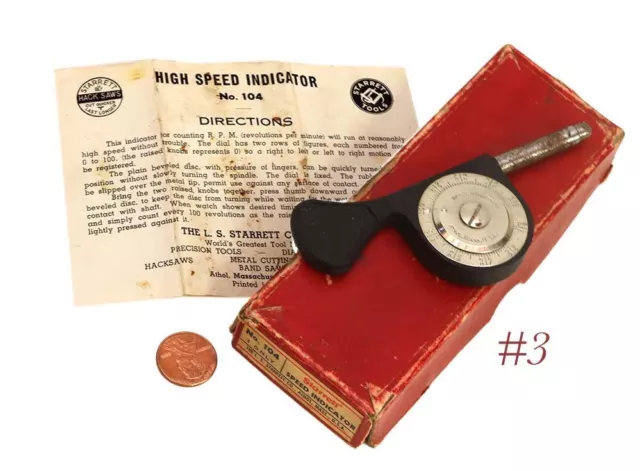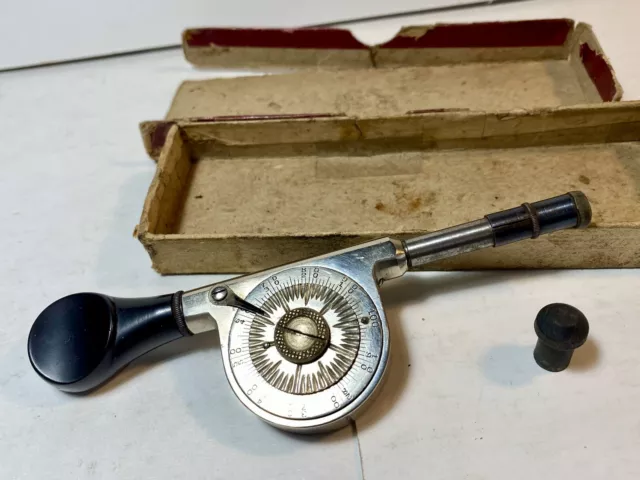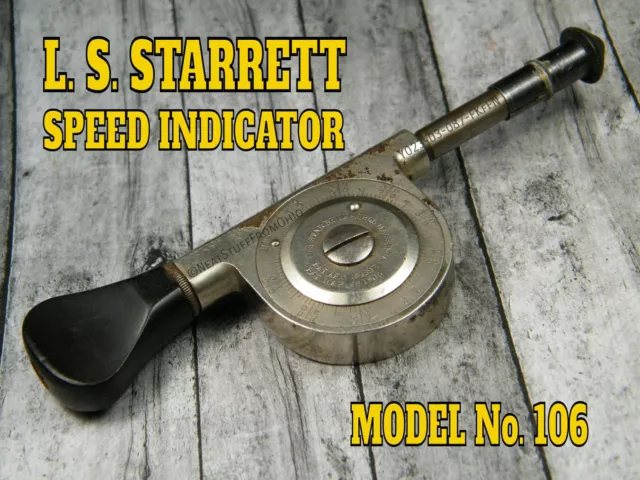STARRETT SPEED INDICATOR No. 106, PATENTED APRIL 13, 1897, NICE ITEM! Circa 1920
$28.99 Buy It Now, Click to see shipping cost, eBay Money Back Guarantee
Seller: neatstufffromohio ✉️ (1,075) 100%,
Location: Dayton, Ohio, US,
Ships to: US & many other countries,
Item: 355010616619
STARRETT SPEED INDICATOR No. 106, PATENTED APRIL 13, 1897, NICE ITEM! Circa 1920. STARRETT SPEED INDICATOR MODEL No. 106, PATENTED APRIL 13, 1897, NICE ITEM! Circa 1920. MANUFACTURED BY: THE L. S. STARRETT COMPANY ATHOL, MASSACHUSETTS IMPROVEMENT IN ROTARY MEASURES LAROY S. STARRETT, INVENTOR. QUANTITY: ONE L. S. Starrett vintage speed indicator; Model Number 106. ABOUT THE ITEM: This particular device / tool was used for measuring and calibrating items that rotated, such as: Drills, lathes, dynamos, presses, motors, steam engines and other devices that employed a spindle, shaft, belt, or pulley. Machinists' bits, dies and mills needed to rotate at so many rotations per minute (i.e. RPM) to control the quality of the final product, avoid overheating, and control the rate of feed. This pocket-size device was used to manually adjust the machines' governors or regulators to obtain the desired speed. After a particular machine was running, the "rotary measure" (i.e. speed indicator) was "touched" to the center of the shaft that was to be metered - - - while the operator referenced a pocket watch. Each time the shaft turned, the worm-screw (also known as a worm-spindle), would rotate one revolution causing the numeric indicator on the dial to increase by one-digit (there are one-hundred teeth on the dial). Each time the dial rotated one full revolution, the count was increase by 100 and then added to the final number on the face of the dial (when the speed indicator was pulled off at the end of one-minute). The registering dial (the center dial) on the face of the device could be quickly rotated to the "zero point / starting point" prior to taking the next measurement (which saved loads of time). Starrett's speed indicator had two raised "dimples" on the face, allowing the operator to watch the device being measured while "feeling" each time the dial lapped (the raised dimple would pass under his operator's finger). Wide finger grips were intentionally incorporated into speed indicators to allow for heat dissipation (these devices could become very hot when used for prolonged periods of time). An additional improvement was the device's ability to read left or right (its graduations ran from zero up to 100 AND from 100 down to zero). Starrett advertised its speed indicators extensively between the late 1890's through about 1930. Publications such as Popular Science Monthly, December 1930, Page 107; Popular Mechanics, January 1905, Page 180 ($1.00 each); Electrical Engineer, January 6, 1898, Page 36; The Engineer, January 1, 1908, Page 132 ($3.00); Southern Engineer, July 1910, Page 38 carried advertisements for the Model 104. Starrett also made a Model 107 speed indicator which incorporated a rubber handle for use when measuring electrical devices (to reduce the likelihood of electrocution of the operator) and a Model 106 that appears to have a Bakelite (i.e. Polyoxybenzylmethyleneglycolanhydride) thumb grip that rotated under pressure (to minimize the possibility of inadvertent electrocution and allow to the gauge to spin in the event it "grabbed" and spun). APPROXIMATE DATE OF MANUFACTURE: Based upon our research, we believe this particular speed indicator was likely manufactured circa 1920 (thus approximately 100-years old). ABOUT THE PATENTS: The inventor of this speed indicator submitted his Patent Application to the United States Patent Office on May 20, 1895 and was issued United States Patent Number 580,432 on April 13, 1897. (Please see a digital image of the original patent in this listing's photos. The patent image IS NOT included with your purchase). Starrett was also issued United States Patent 601,800 for modifications to the end of the speed indicator which increased the contact with the devices being measured. The Starrett company has been granted over 100 patents over the years to protect their tools and inventions. The inventor indicated his speed indicator included the following improvements: Enclosing case (where the worm gear was not exposed); Flat case; Can easily be reset to zero; Small protuberance on the disk to allow the operator to feel each full rotation; Small disk of anti-friction material placed in the extreme inner end to prevent frictional heating; Other improvements. OVERALL CONDITION / DISCLAIMER: The indicator dial rotates under pressure (as it was designed to). This is a functional speed indicator. We have not tried to loosen the front or rear screws. The gradients on the indicators' dial were stamped and then plated -and- are still clearly visible. The indicator was designed to register up or down (i.e. count left or right revolutions). Small amounts of rust (as would be expected on a machinist's tool that saw daily use), dings, dents, scratches, some plating missing, etc. ABOUT HIS SPEED INDICATOR: This is Starrett's model 106 speed indicator. It appears to have a Bakelite (i.e. Polyoxybenzylmethyleneglycolanhydride) thumb grip that will rotate under pressure. This feature likely provided two benefits: To minimize the possibility of inadvertent electrocution and allow to the gauge to spin in the event it "grabbed" and spun. This counter is one of the many inventions of Laroy Starrett (1836-1922). Laroy was born and raised on a farm in Maine. In 1880, having successfully patented and sold a meat chopper (as well as shoe studs and hooks) Laroy established a business in Athol, Massachusetts to sell drawing instruments and small tools. He applied for a patent for a speed indicator in 1895, and received it in 1897. The United States Patent numbers are L. S. Starrett, “Speed-Indicator,” United States Patent No. 580,432, April 13, 1897 -and- S. P. Walsh, “Speed-Indicator,” United States Patent No. 786,073, March 28, 1905. Stafford P. Walsh of San Francisco, California improved on the instrument, assigning his patent to L. S. Starrett Company when it was granted March 28, 1905. The device was marketed in at least three models. Speed indicators were sold both directly by Starrett and through distributors . This speed indicator is mentioned in Starrett catalogues into the 1930s. DIMENSIONS AND WEIGHT: This speed indicator measures approximately 5.26" long (including the extension and rubber tip) by 0.56” thick by 1.89” wide and weighs 3.9 ounces (110 grams). The rotating dial has a diameter of approximately 1.03". We have researched this device extensively and determined that advertising for the Starrett Speed Indicator started to appear in various publications around 1899 and then pretty much disappeared around 1930. ABOUT THE L. S. STARRETT COMPANY: The L. S. Starrett Company was located in Athol, Massachusetts and during 1921 had stores at 90-92 West Broadway in New York -and- 17 North Jefferson Street in Chicago. They also had a warehouse at 36 & 37 Upper Thames Street in London, England. L. S. Starett company specialized in machinists and mechanics tools such as: Calipers, Center Punches, Clamps, Countersinks, Dividers, Draftsman's Tools, Drill Blocks, Gages, Ground Flat Stock, Hack Saws and Frames, Inclinometers, Jack Screws, Leveling Instruments, Micrometers, Nail Sets, Pin Vises, Pliers, Plumb Bobs, Protractors, End Measuring Rods, Rules, Scrapers, Speed Indicators, Squares, Straight Edges, Steel Tapes, Test Indicators, Trammels and Transits. SHIPPING COST꞉ Your shipping cost is calculated when checking out. To keep your shipping cost as low as possible, it's based on “DIM” (i.e. weight, package size and final destination). This item ships by United States First Class Mail or eBay International Delivery. Orders typically ship within one business day of your payment being received.
- Condition: Used
- Condition: Please see the listing description and photographs for any conditional issues.
- Brand: Starrett
- Country/Region of Manufacture: United States
PicClick Insights - STARRETT SPEED INDICATOR No. 106, PATENTED APRIL 13, 1897, NICE ITEM! Circa 1920 PicClick Exclusive
- Popularity - 0 watchers, 0.0 new watchers per day, 229 days for sale on eBay. 0 sold, 1 available.
- Best Price -
- Seller - 1,075+ items sold. 0% negative feedback. Great seller with very good positive feedback and over 50 ratings.
People Also Loved PicClick Exclusive

STARRETT SPEED INDICATOR No. 106, PATENTED APRIL 13, 1897. Circa Early 1900s
$22.50 Buy It Now 28d 17h
STARRETT SPEED INDICATOR No. 104, PATENTED APRIL 13, 1897, NICE ITEM! Circa 1900
$21.99 Buy It Now 14d 12h
Antique L S Starrett Machinist's Speed RPM Gauge Indicator
$8.99 0 Bids 1d 8h
THE L.S. STARRETT CO. Combination Square Ruler COLLECTIBLE VINTAGE ANTIQUE OLD
$24.99 0 Bids 1d 23h
104 STARRETT machinist SPEED INDICATOR w box
$20.00 Buy It Now 23d 8h 1 watcher
1 watcher Antique Starrett Patent April 13, 1897 Speed Indicator Tool Nice$29.99 Buy It Now or Best Offer
Antique Starrett Patent April 13, 1897 Speed Indicator Tool Nice$29.99 Buy It Now or Best Offer 1 watcher
1 watcherVintage Starrett No. 107 Registering Speed Indicator with Box & Tip USA
$10.00 0 Bids 6d 11h


